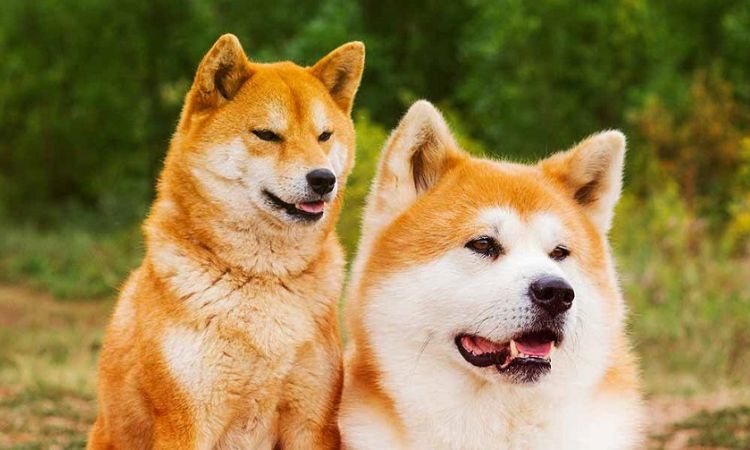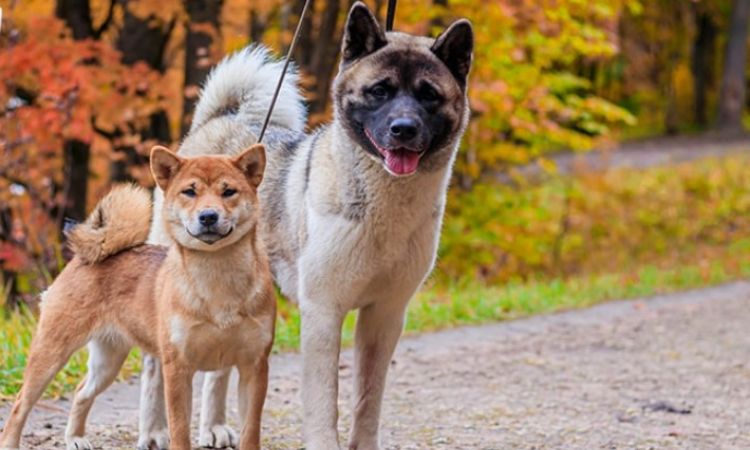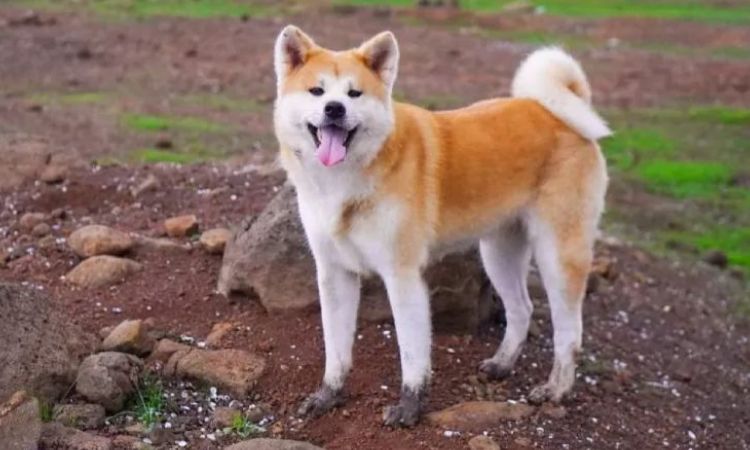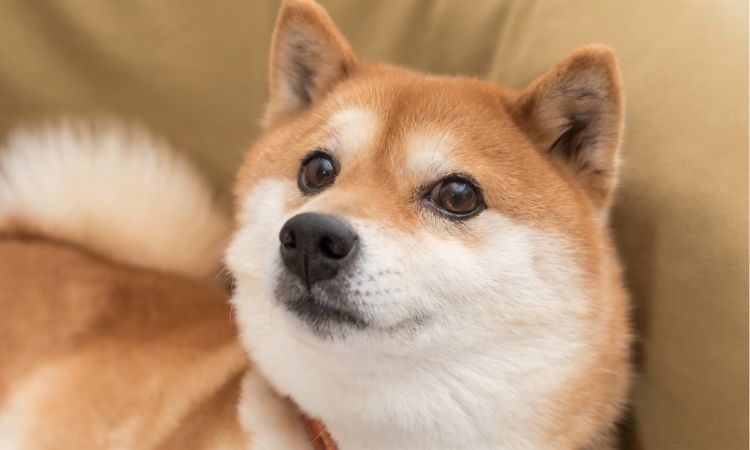If you’re searching for a loyal, intelligent dog with a striking appearance, the Akita and Shiba Inu both make strong contenders. Though they may look somewhat alike at first glance, these two breeds differ greatly in size, temperament, and care.
Whether you’re leaning toward the calm strength of the Akita or the bold energy of the Shiba Inu, Nexus-pets is here to guide you through a clear, side-by-side comparison to help you find the best fit for your home and lifestyle.

Physical Differences
Although the Shiba Inu and Akita share similar ancestral roots and a distinctly Japanese aesthetic, their physical differences are striking and often the easiest way to tell them apart. From size and build to coat characteristics and tail shape, each breed has its own signature appearance.
Size and Weight
- Akita: A large, powerful dog with a sturdy, muscular build. Males typically stand between 26–28 inches tall and weigh 100–130 pounds, while females range from 24–26 inches and weigh 70–100 pounds.
- Shiba Inu: Much smaller in comparison, Shibas are considered small to medium-sized dogs. They usually stand between 13–17 inches tall and weigh between 17–23 pounds.
Coat Type and Colors
- Both breeds have a double coat: a dense, soft undercoat beneath a straight, harsh outer layer. This gives them their plush and weather-resistant fur.
- Akita: Comes in a broad range of colors including red, white, brindle, black, fawn, and pinto — sometimes with striking facial markings or body patterns.
- Shiba Inu: Has a more limited palette, typically seen in red, black and tan, sesame (red with black-tipped hairs), and cream.
Tail Characteristics
- Akita: Known for its thick, heavily curled tail that arches prominently over the back, often forming a full or even double curl.
- Shiba Inu: Also sports a curled tail, but it’s generally slimmer and less dramatic in curl than that of the Akita — more of a gentle arch or tight roll over the back.

Temperament and Personality
While both the Akita and Shiba Inu are known for their independence and strong-willed nature, their personalities differ in key ways that may influence which breed suits your lifestyle best. Understanding their temperament can help set realistic expectations for training, bonding, and everyday life.
Akita
Akitas are dignified and loyal companions, often described as calm, serious, and deeply devoted to their families. They are naturally protective and can be wary of strangers, making early socialization essential. While not overly demonstrative, they form strong emotional bonds and are known for their quiet confidence and steady presence in the home.
- Loyal and deeply attached to their family
- Naturally protective and excellent watchdogs
- Calm and composed, especially indoors
- Independent thinkers; not ideal for first-time owners
- Reserved or aloof with unfamiliar people
- Needs consistent socialization and respectful handling
Shiba Inu
Shibas are spirited little dogs with bold personalities packed into a compact frame. Often likened to cats in their independence and grooming habits, they are playful, alert, and energetic. Though friendly, they can be selective with affection and sometimes aloof, especially with strangers. Their curious and confident demeanor requires consistent guidance to prevent stubborn behavior.
- Alert and highly aware of their surroundings
- Fearless and self-assured, sometimes too much so
- Playful and energetic, especially when young
- Independent and occasionally stubborn
- Can be aloof with people or pets they don’t trust
- Benefits from early training and lots of mental stimulation
Trainability and Exercise Needs
When it comes to training, Akitas generally show a higher level of trainability compared to Shiba Inus. They respond well to consistent, firm, and respectful training methods, especially when socialization begins early in their development. Akitas tend to be loyal and eager to please but can also display independence, so establishing yourself as a confident pack leader is essential for successful training and behavior management.
In contrast, Shiba Inus are known for their stubborn streak and strong-willed nature, which can make training more challenging. Their independent mindset often leads them to selectively obey commands, requiring owners to exercise patience, creativity, and consistency. Despite this, Shibas are intelligent dogs who thrive on mental stimulation and enjoy opportunities to explore their environment, which also helps in their training and overall happiness.
Regarding exercise needs, Akitas require a moderate amount of physical activity. While they enjoy outdoor walks and playtime, they do not demand constant high-energy exercise and can adapt to a more relaxed routine if adequately stimulated mentally. Shiba Inus, on the other hand, are more energetic and alert dogs. They have higher activity levels, showing enthusiasm for exploring, running, and interactive play. This makes regular exercise vital to keeping them healthy and content, as well as preventing behavioral issues arising from boredom.
In summary, Akitas are typically more trainable with consistent leadership and require moderate exercise, while Shibas need more patience during training and benefit from frequent physical and mental activity to satisfy their lively and inquisitive nature.
Health and Lifespan
Akita Health Concerns

Akitas are prone to some serious health issues like bloat (a dangerous stomach condition), hypothyroidism (a thyroid disorder), and progressive retinal atrophy (PRA), which affects their eyesight. They can also have hip and elbow dysplasia, autoimmune diseases, and other conditions. Regular vet checkups are important to catch these early.
Shiba Inu Health Concerns

Shibas are generally healthier and hardier, but they can still have problems like hip dysplasia, some types of cancer, and PRA. They may also experience knee issues (patellar luxation), allergies, and rare neurological disorders.
Lifespan:
- Shiba Inu: Usually lives 13 to 16 years
- Akita: Typically lives 10 to 14 years
Because Shibas are smaller and generally more robust, they tend to live longer. Both breeds benefit greatly from good care, proper diet, exercise, and regular vet visits.
Popularity and Living Conditions
Akita: The Akita is Japan’s national dog, prized as a guard dog, hunter, and loyal companion. Due to their large size and energy needs, they require spacious living areas, such as homes with yards. Akitas are best suited for experienced owners who can provide firm training and plenty of space to roam. They are less ideal for apartment living or small homes.
Shiba Inu: Shibas are more popular globally as family pets. Their smaller size and moderate exercise needs make them a great fit for smaller homes or apartments. Shibas are affectionate but independent, often exhibiting catlike behaviors. They thrive with owners who understand their unique personality and provide consistent socialization.
Cost and Availability
When considering bringing home an Akita or a Shiba Inu, understanding the cost and availability of these breeds is important. Generally, Akitas are more affordable, with prices ranging from $600 to $2,000. Shiba Inus, due to their rising popularity, tend to be more expensive, usually costing between $2,000 and $3,500.
Finding a reputable breeder is essential for both breeds to ensure the health and quality of your new companion. While Shibas are often easier to find because of their popularity, both breeds require responsible breeding practices. Choosing breeders who provide health clearances and prioritize ethical breeding will help prevent hereditary health problems and support your dog’s well-being.
Whether you lean towards the majestic Akita or the spirited Shiba, both breeds offer unique joys and challenges. We’ve delved deep into their distinct personalities, sizes, grooming needs, and training requirements, providing a comprehensive look at what sets these two incredible Japanese dogs apart. Remember, the “best” breed isn’t universal; it’s the one that perfectly aligns with your lifestyle, living situation, and what you’re looking for in a loyal companion.






